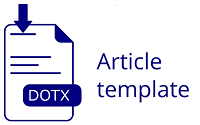Pengaruh Social Electronic Word Of Mouth (Ewom) Terhadap Keputusan Pembelian Melalui Brand Image Lazada (Studi Pada Mahasiswa Fakultas Ekonomi Dan Bisnis Universitas Trunojoyo Madura)
Abstract
This study aims to determine the effect of Social eWOM on Brand Image, determine the effect of Social eWOM on Purchase Decisions, determine the effect of Brand Image on Purchase Decisions, and determine the influence of Social eWOM on Purchase Decisions through Brand Image on Lazada users at the Faculty of Economics and Business, Trunojoyo University Madura.The sample used in this study were 97 respondents who had shopped at Lazada. The sample was selected by purposive sampling method. The analytical techniques used were descriptive analysis, validity, reliability, classical assumptions, and path analysis.
The results of this study indicate that: (1) Social eWOM (X) has a significant direct effect on Brand Image (Z) (2) Social eWOM (X) has a direct significant effect on Purchase Decisions (Y) (3) Brand Image(Z) has a direct significant effect on Purchase Decision (Y). (4) Social eWOM (X) has a significant indirect effect on Purchase Decisions (Y) through Brand Image (Z). The results of the path coefficients show that there is a significant relationship between (X→Z) Thus, it can be stated that Social eWOM (X) indirectly has a significant effect on Purchase Decision (Y) through Brand Image (Z) with an effect of 0.266 or 26.6%
Full Text:
PDFReferences
Ali Hasan. 2010. Marketing. Yogyakarta: Media Pers.
Arikunto. 2004. Prosedur Penelitian Suatu Pendekatan Praktek. Edisi Kelima. Jakarta:Rineka Cipta.
Assauri, S., 2015. Manajemen Pemasaran. Jakarta: PT Raja Grafindo Persada.
C, K, Laudon., Traver, 2017. E-Commerce 2014, 10th Edition. Pearson.
Chu, S.C., and Kim, Y., 2011. Determinants of consumer engagement in electronic word-of-mouth (eWOM) in social networking sites. International Journal of Advertising, Vol. 30: 47-75.
Ellison, N.B. and Boyd, D., 2013. Sociality through Social Network Sites. Oxford University Press, Oxford, pp. 151-172.
Graham, J. and Havlena, W., 2007. Finding the missing link advertising’s impact on word of mouth, web searches, and site visits”. Journal of Advertising Research, Vol. 47: 427-435.
Hailin Qu, et al., 2011. A Model Destination Branding: Intergrating the Concept of
Hennig-Thurau, T. et al., 2004. Electronic word-of-mouth via consumer-opinion platforms: What motivates consumers to articulate themselves on the Internet. Journal of Interactive Marketing,18(1), pp.38–52.
Hu, X. and Ha, L., 2015. Which form of word-of-mouth is more important to online shoppers? A comparative study of WOM use between general population and college students. Journal of Communication and Media Research, Vol. 7 No. 2, pp. 15-35.
Hu, X., Ha, L., Mo, S. and Xu, Y., 2014. Who are fans of Facebook fan pages? An electronic word-of-mouth communication perspective. International Journal of Cyber Society and Education, Vol. 7 No. 2, pp. 125-146.
Jalilvand, M.R. and Samiei, N., 2012. The Effect of Electronic Word of Mouth on Brand Image and Purchase Intention: An Empirical Study in the Automobile Industry in Iran. Marketing Intelligence & Planning, Vol.30 No.4, pp.460-476.
Jeong, H.J. and Koo, D.M., 2015. Combined effects of valence and attributes of eWOM on consumer judgment for message and product: the moderating effect of brand community type. Internet Research, Vol. 25 No. 1.
Kotler dan Gary Amstrong. (2016). Dasar-dasar Pemasaran.Jilid 1, Edisi Kesembilan.Jakarta: Erlangga.
Kotler dan Keller, 2012. Manajemen Pemasaran. Jilid 1 dan 2. Edisi 13. Bob Sabran (Penerjerjemah). Jakarta: Erlangga
Kotler, Philip and Kevin Lane Keller, 2016. Marketing Managemen, 15th Edition.
Kotler, Philip., Keller, Kevin L. 2013. Manajemen Pemasaran, Jilid Kedua.
Lovelock, C, dan John Wirtz, 2011. Pemasaran Jasa Perspektif. Edisi 7. Jakarta: Erlangga.
Nawawi, Hadari, 2012. Metode penelitian Bidang Sosial. Yogyakarta: Gadjah Mada University Press
Poyry, E., Parvinen, P. and Malmivaara, T., 2013. Can we get from liking to buying? Behavioral differences in hedonic and utilitarian Facebook usage. Electronic Commerce Research and Applications, Vol. 12 No. 4, pp. 224-235.
Rui, H., Liu, Y. and Whinston, A., 2013. Whose and what chatter matters? The effect of tweets on movie sales. Decision Support Systems, Vol. 55 No. 4, pp. 863-870.
Sernovitz, 2009. Word Of Mouth Marketing. Jakarta: Gramedia Pusaka utama.
Siregar, S., 2013. Metode Penelitian Kuantitatif Dilengkapi Perbandingan Perhitungan Manual & SPSS Edisi Pertama. Jakarta: Kencana Prenada Media Group.
Sugiyono, 2016. Metode Penelitian Kuantitatif, Kualitatif dan R&D. Bandung: PT Alfabet.
Sugiyono, 2017. Metode Penelitian Kuantitatif, Kualitatif, dan R&D. Bandung: Alfabeta, CV.
Turban, Efraim. et. al. 2015. Electronic commerce a Managerial and Social the branding and destinaton image.
DOI: https://doi.org/10.21107/jkim.v1i3.13475
Refbacks
- There are currently no refbacks.
Copyright (c) 2022 Jurnal Kajian Ilmu Manajemen (JKIM)




